Blog Archives
Hotel Wine tastings – the final tastings from my trip to Paris – May 2025
As stated in my previous post, I was in Paris in Late May, with Avi Davidowitz from Kosher Wine Unfiltered. This trip was not about numbers, but rather about sheer logistics. The number of boxes across the number of hotels was more than I wished for! Of course, this was totally self-inflicted, as Avi was coming in for business the week before, and I was juggling too much at home. In the end, it was a far more relaxing trip, as the sheer number of wines was more in the 40s than the usual 60 or 80 wines. A lot of that can be blamed on the number of 2024 or new 2023 wines on the market – there are just ZERO new wines out there. There are loads of old 2022 and 2023 roses in the stores in Paris, and the same can be said for older whites and reds. Wines are not moving, and as such, there was less new stuff to taste.
Two years ago, we had some 80 wines; this May, we were at 40+ wines. There were a few wines that Avi missed, and a few I wished he was able to see evolve, but that is the game as we know it!
The wines were tasted in classic region/style order: Rosés, whites, Wines from Spain and Italy, a single Burgundy, Bordeaux/Blend wines, and I think that is it.
Rose Wines
We had a total of 10 Roses, and there was just one 2024 Rose in the stores. The rest of the wines came from a combination of Mercier Wines, Capcanes Winery, Terra di Seta Winery, and Taieb wines. The hands-down best Rose I had so far this year is locked away in Paris, and that is the 2024 Château Sainte Roseline Lampe de Méduse – Cru Classé Rosé. This is the first time I have tasted this wine, and it was clean, controlled, and refreshing. That is a wine to BUY lots of for the summer.
I have often posted about Taieb wines, and if you want to read the whole background, read the first post I made here.
The 2024 Cave D’Esclans Whispering Angel and the 2024 Château Sainte Roseline Lampe de Méduse – Cru Classé Rosé are the two Rose WINNERS from the tasting. The 2024 Elvi Wines Vina Encina Rosado was a solid wine, along with the N.V. Summer Ice Rose.
White Wines
We tasted through a lot of white wines. One of them I brought from the USA for Avi to taste was the 2023 Alex Rubin Arinto. That is a wine that I posted about earlier and one that Avi loved as much as I did. The 2023 Chevalier De Marmorieres Blanc was a shocking WINNER find along with the always enjoyable Herenza White. I have no idea why the Herenza White doesn’t move well in the USA; I have no idea! Folks buy a few and try.
On a slight rant, I will start with the positives, thankfully, we have more kosher white wine available now than ever before, PERIOD! However, what is clear is that the kosher-buying public has made Sauvignon Blanc and Chardonnay their next Cabernet Sauvignon! I am happy you are all starting to enjoy white wines – finally! But good Lord, there are OTHER white wines out there! As stated, I am firmly on the ABC train, outside of a few Cali and France. Sauvignon Blanc is a wonderful grape and please ignore EVERYTHING that Avi says to the contrary, it is not his fault, he has issues with good wine!
Now, all I see is that white wines that are not Chardonnay or Sauvignon Blanc linger on physical or virtual shelves. Thankfully, most of you get Riesling, almost. But that is it! You guys killed the only good Albarino from Ramon Cardova because you all refused to buy it! The Herenza is the same, and this wine is 30 to 40 percent Sauvignon Blanc! OK, I’ll give up and stop my rant here! TRY OTHER white wines – please!
The rest of them are wines that you can try and see if you like.
Italian and Spanish Wines
Overall, the red wines were split between Italy/Spain and Burgundy/Bordeaux. However, the hands-down leader in QPR (Quality to Price Ratio) WINNER scores was Spain and Italy. Spain and Italy had 12 wines, and 7 of them won the QPR score of WINNER.
I must be honest here, I drove everyone crazy! Moises at ElviWines, Jurgen at Capcanes Wine Cellars, and Daniele at Terra di Seta. All of them were very kind to send us samples. The cool thing is, we got to taste Terra di Seta wines long before they appear on the USA shores, or at least before they are released for sale. The same can be said for Elvi Wines; we tasted yet unreleased wines here in the USA. Finally, the Capcanes wines may be released, but either way, they are solid. Our sincere thanks to all of them for taking the time and sharing their excellent work with us!
The seven QPR WINNERS were the
- 2022 Elvi Wines Adar
- 2022 Elvi Wines Herenza, Crianza
- 2023 Capcanes Peeraj Ha’abib
- 2021 Terra di Seta Chianti Classico, Riserva
- 2021 Terra Di Seta Guiduccio
- 2022 Elvi Wines El26
- 2019 Terra di Seta Chianti Classico, Assai, Gran Selezione (which Avi did not taste).
The 2022 EL26 was another stunning Grenache-based red wine, and I cannot say it enough, Elvi is crushing it over and over and over again! The Adar is a lovely Mevushal option that is not sold here in the USA, though it sells nicely in Israel. The 2022 Elvi Herenza Crianza is equally impressive.
Terra di Seta has once again released some lovely new wines, but they will not be available in the USA for a bit. The 2021 Terra di Seta Chianti Classico, Riserva is beautiful, along with the 2021 Terra Di Seta Guiduccio, which shows more refined than the 2020 Guido. Finally, the wine that Avi did not taste, the 2019 Terra di Seta Chianti Classico, Assai, Gran Selezione, is mind-blowing! Pure mushroom and soy sauce heaven.
A single Burgundy and Bordeaux Wines
As is familiar with our hotel wines, they open slowly and they are very hard to get a grip on until we are almost on a plane home. I have no idea why this is the case; it feels like it is the curse of the hotel, but we have stayed in different hotels, and the theme remains the same. Also, this phenomenon happens ONLY with Bordeaux wines. The rest of the red wines we taste and the whites open as we expect. The 2020 and 2021 Chateau Olivier Blanc are wines that took 6 days to come around. The 2023 Chateau de Rayne Vigneau Grand Vin Blanc Sec took 6 days to open! I have no idea, no explanation. I am not a chemist, and I am not going to speculate. What I will state is FACT! Wines we taste in the hotel room, for reasons unexplained, just take a LONG time to come around.
So, it was NO surprise when the main wines we were looking forward to tasting went silent for three days. The 2022 Château Angelus Carillon de l’Angélus was closed for four or more days. The 2022 Relais de La Dominique was literally red water for three days. The 2022 Chateau Haut Condissas Prestige was an open book from the start. The 2022 Château Tour Baladoz was closed for two or more days. The 2022 Chateau Haut Brisson may have been the WORST of the bunch – changing over four days from red water to a lovely wine. The 2022 Chateau du Courneau was there and available from the start! The 2022 Vieux Chateau Chambeau Reserve was as open as the time I had it in San Jose. I bought it to make sure that Avi tasted it.
The TRUE SHOCKER was the 2022 Chateau Rocher Gardat! Yes, you have a good memory. We tasted this wine back in 2024. However, my memory isn’t as good, so when I am walking around Paris, I buy what I see. Turns out it was indeed a wine we had tasted and given time to come around, and it never did. HOWEVER, this time, the wine was a shocking WINNER! It showed incredible acidity, pop, and fruit structure, and for the price, GOOD LORD, that is a clear WINNER for Bokobsa! The joy of a feeble mind when in Paris!
In case you were wondering there were four QPR WINNER wines. I will leave it up to you to guess, or you can look below. One of them should be STUPID obvious, the other two, not so much, but hey, that is the joy of wine!
The rest of the wines were average and available, but not exciting.
Where can you buy these wines?
The Taieb wines will find their way to the USA through a menagerie of importers. Those include Liquid Kosher, Kosher Wine, and Victor Wines, which I continue to be baffled at where these wines actually sell, outside of Florida! The Elvi wines are already available in the USA. The Capcanes Cellar wines are already here. The Terra di Seta wines are now available in the USA, but their release will be delayed until the current stock is depleted. Then you have the Mercier Wines, none of which are here, I think. The 2022 Chateau Haut Brisson, 2023 Chateau Angelus Tempo d’Angelus, and the 2022 Château Angelus Carillon de l’Angélus are either available in the USA or on their way; I’m not sure. I saw a bottle on social media, but we can’t be sure if it’s actually here or was brought in by hand.
The 2022 Vieux Chateau Chambeau Reserve is readily available in the USA,
The Mercier wines will find their way here once the previous vintages are sold. As for the rest of the wines, I have no idea!
As always, the 2022 Pavillon de Leoville Poyferre is the Non-Mevushal version of the wine, and is only available in France, the UK, and Israel. We bought it because we couldn’t get a tasting of it – sadly, it didn’t show any better than its Mevushal version.
I have no idea what is going on with all the 2022 Rollan de By wines. These were all made by Taieb, but for some reason, they are not being imported into the USA, and they are hard to find in France, as well. The Condissas is a clear WINNER, but that only helps if you can find it!
Thoughts on this tasting
OK, so overall, this tasting was great! This was better than previous tastings because the 2022 vintage has shown far better than I originally imagined, unlike other hotel wine tastings. Of the 40+ wines that we tasted, 31 of them garnered scores that would be acceptable to most people. That is a great showing! 31 of 40+ wines! Good stuff! Still, Kosher plonk exists in spades in all regions of the world! The USA may have the largest availability to them, but Paris is not far behind!
Regarding other wines from France that people will ask me about, the answer is that we tried. We sent out emails and received initial responses, but all subsequent follow-up emails were directed to the Spam Bucket. Sometimes, I wonder if French people hate us Americans! Anyway, the winning lineup is impressive and holds wines that you should be buying. I sure will! There are a couple of wines that were not in that picture, but the scores will make clear they deserved to be there. The issue was that one wine was not delivered until after Avi left, and the others improved after that time as well. So, like I said, these wines take time to come around.
Before I forget – Avi took all the pictures from this trip, so if you dislike them, blame him. If you love them, disregard the previous sentence! Thanks, buddy!! Thankfully, this time we got all the wine pictures!
Finally, 100% of the deliveries were to the hotel this time. I have essentially stopped bothering my man Ari Cohen, AKA El-Presidente of Bakus Wines. He has essentially become totally AWOL on our trips. I think the more I go to Paris, the less I get to see him – maybe I am finally becoming a Parisian! Thanks for all the help, as always, buddy!
The wine notes follow below in the order that they were tasted. The explanation of my “scores” can be found here and the explanation for QPR scores can be found here:
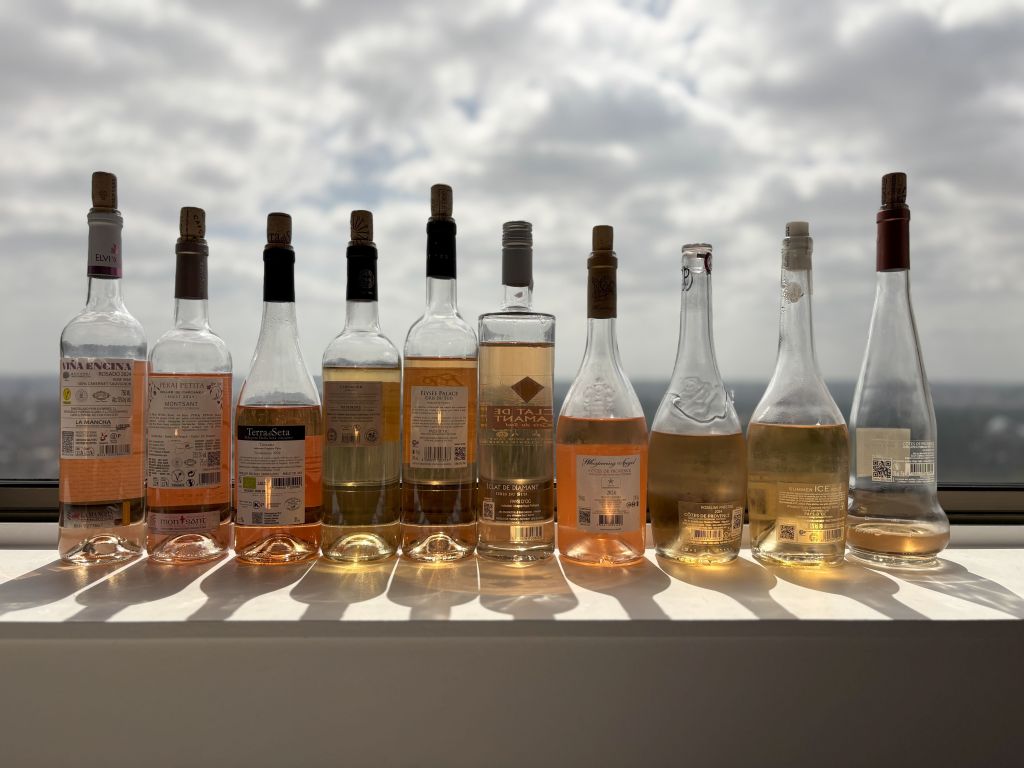
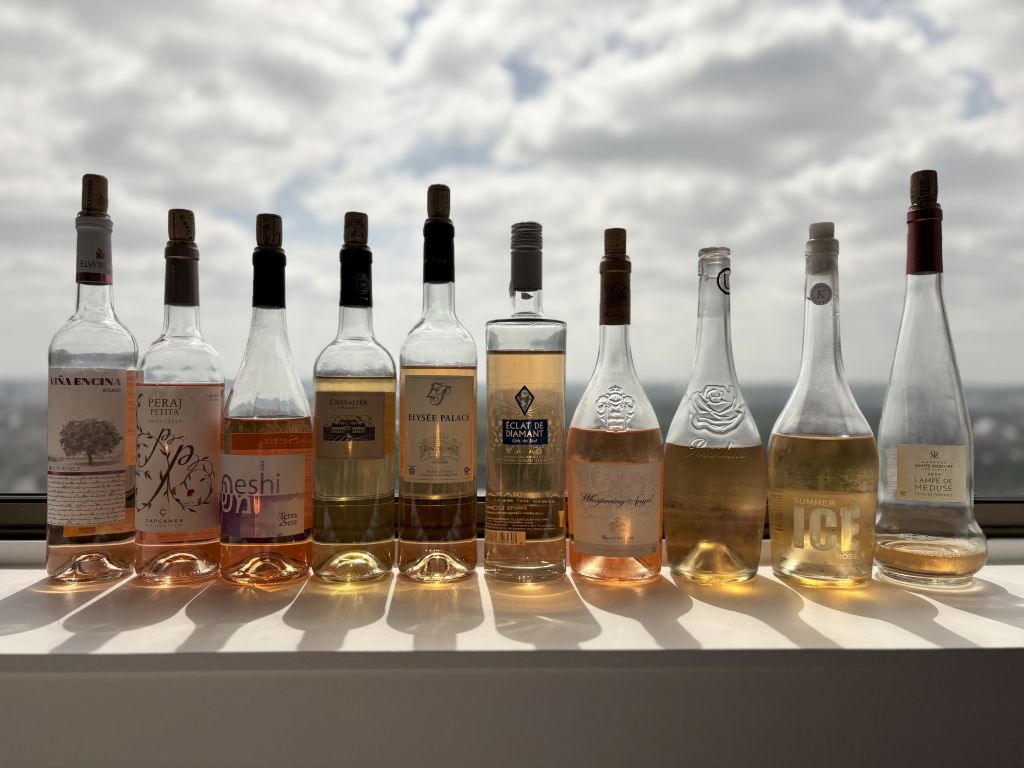
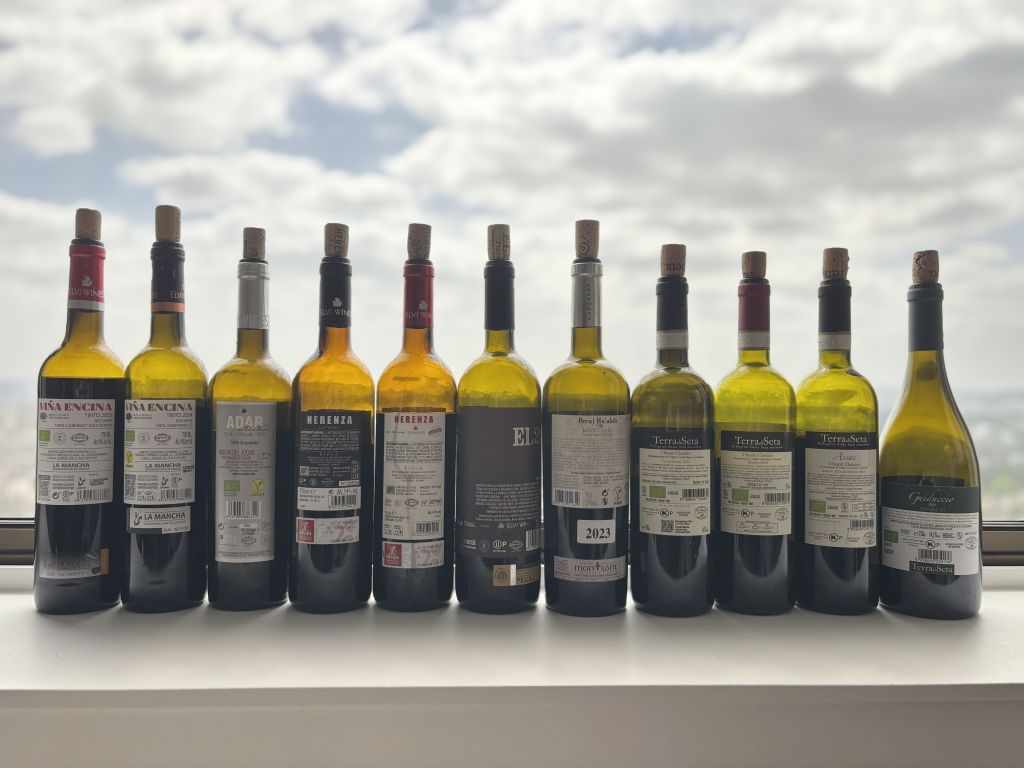
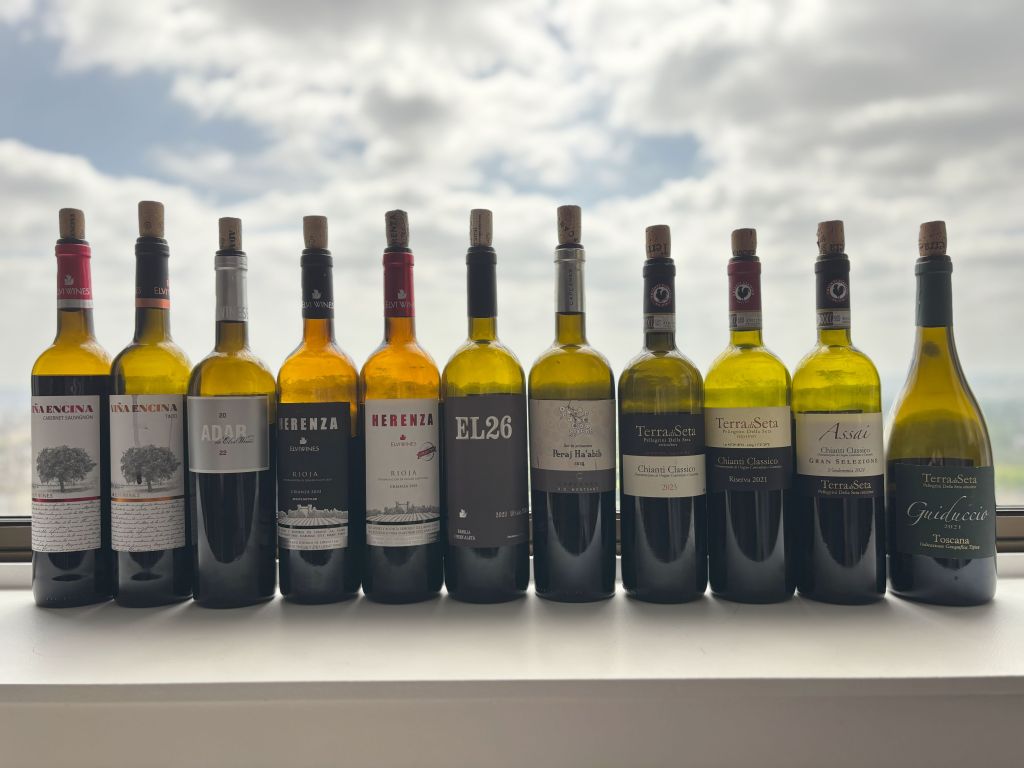
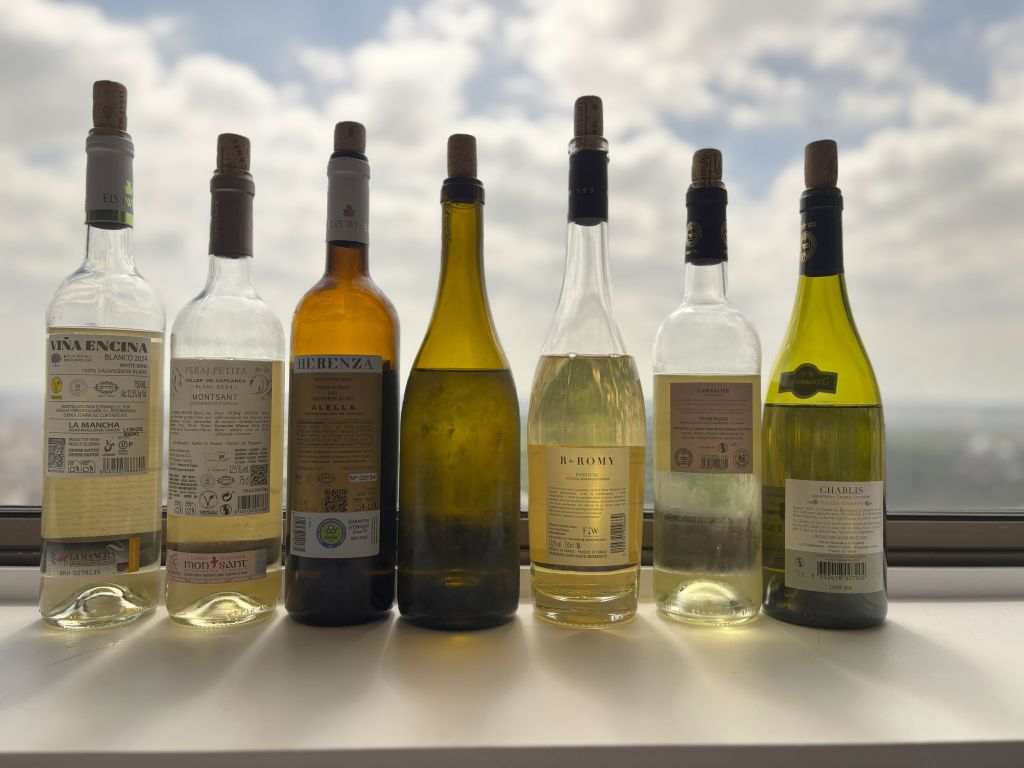
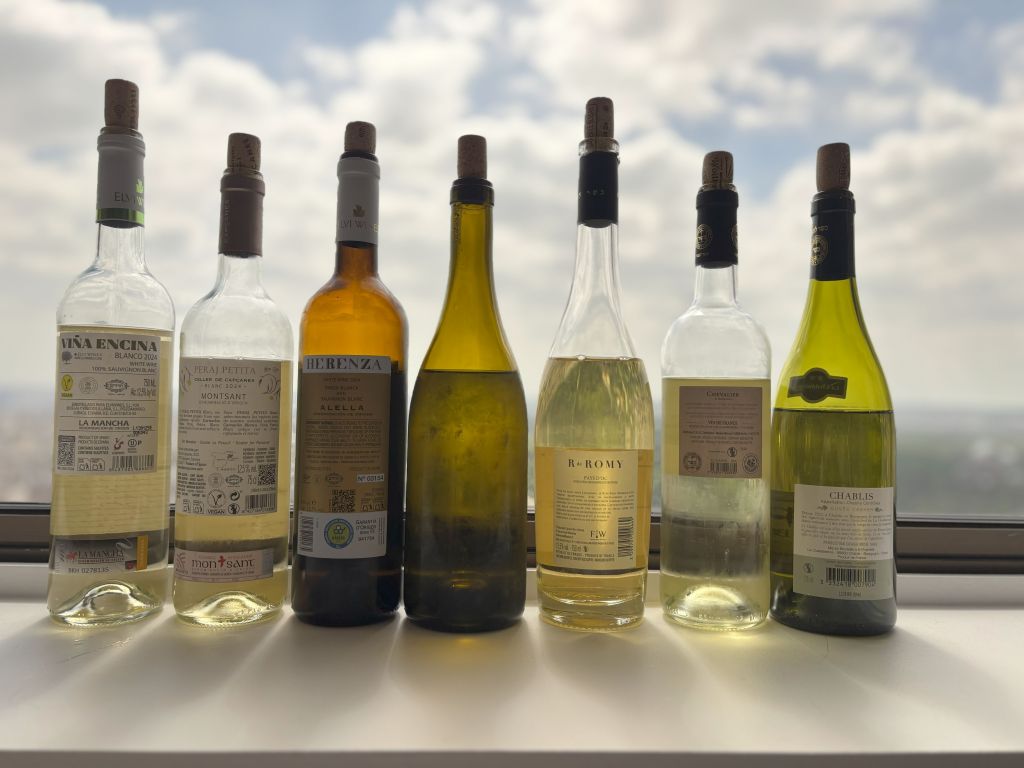
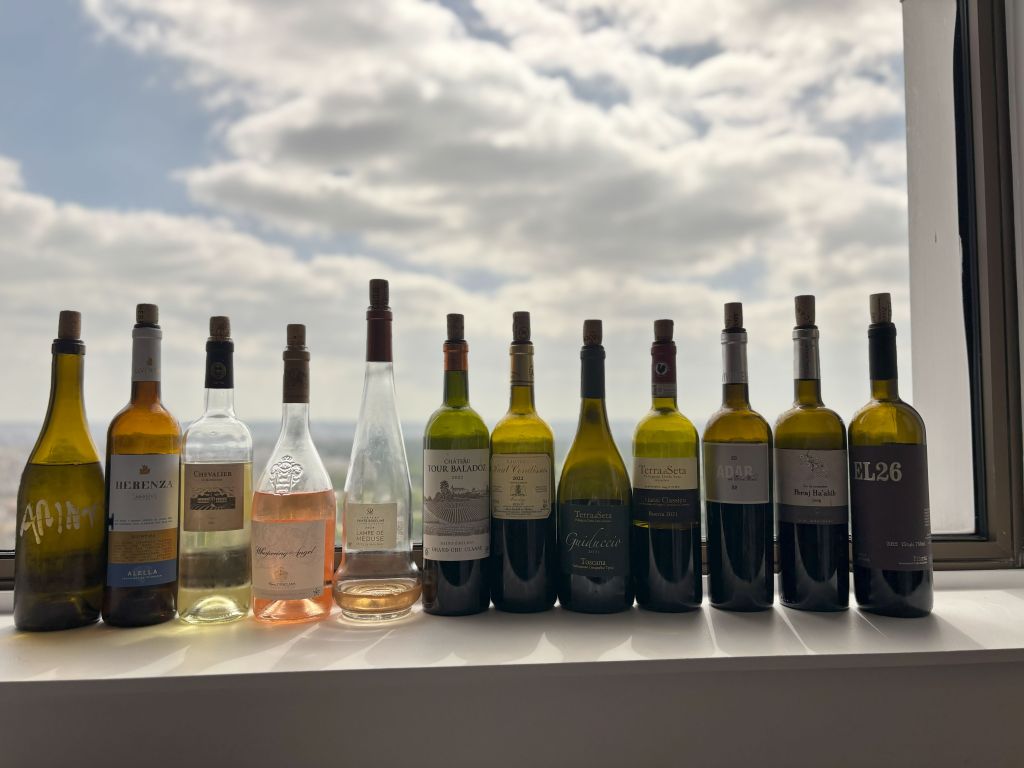
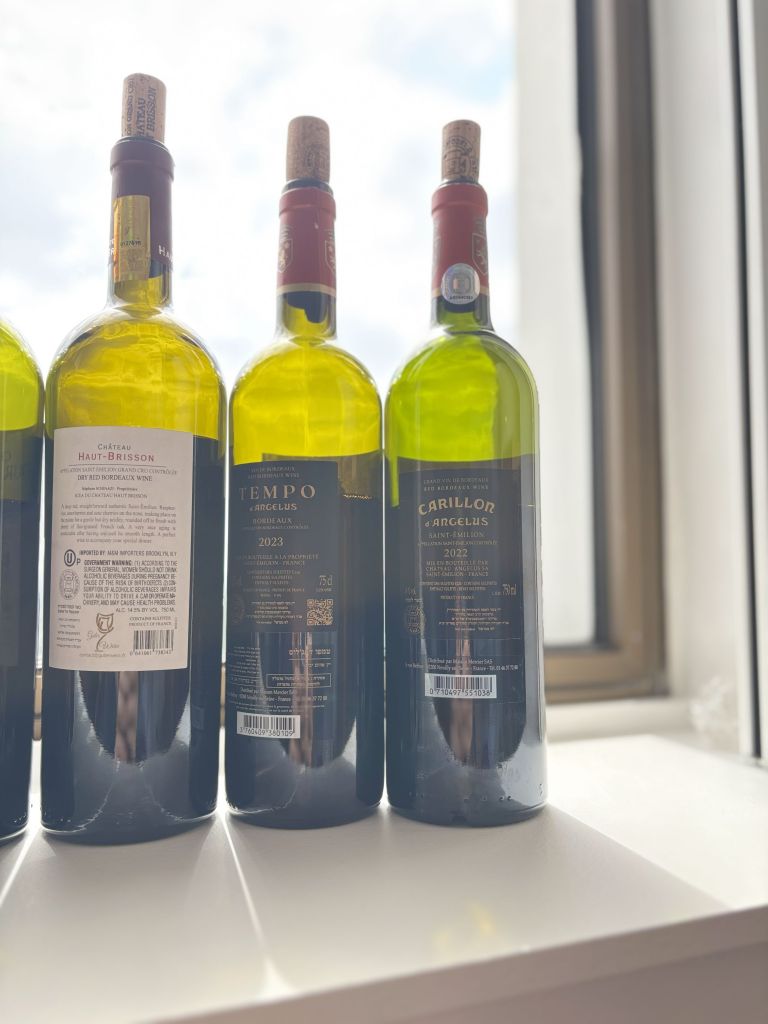
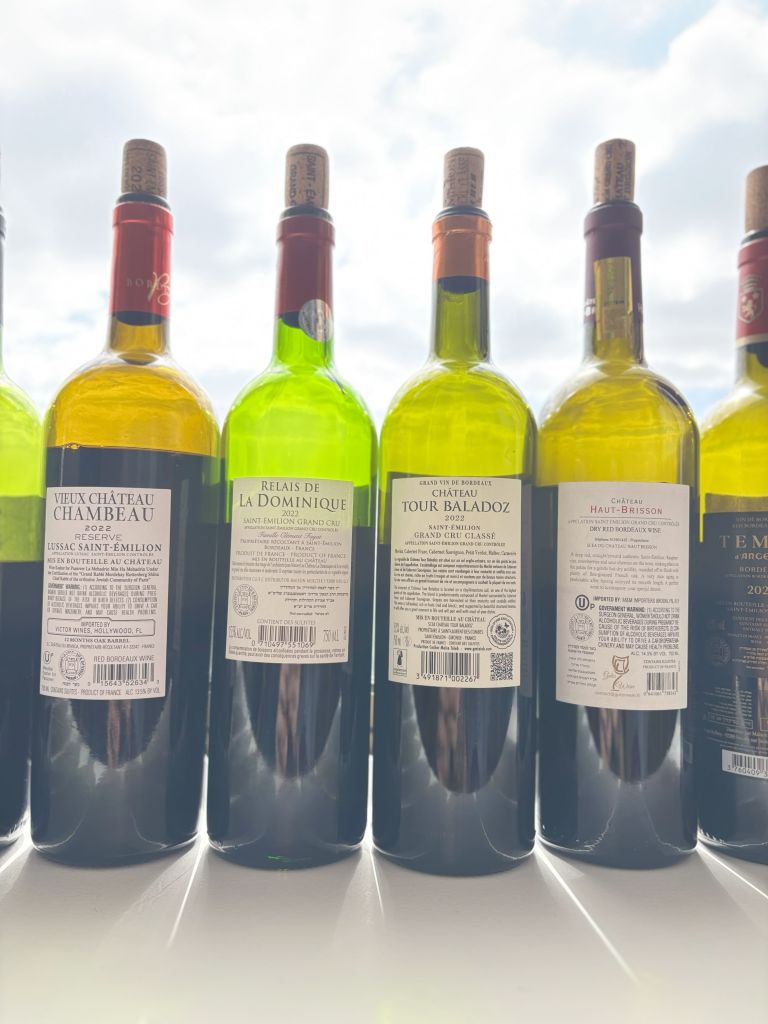
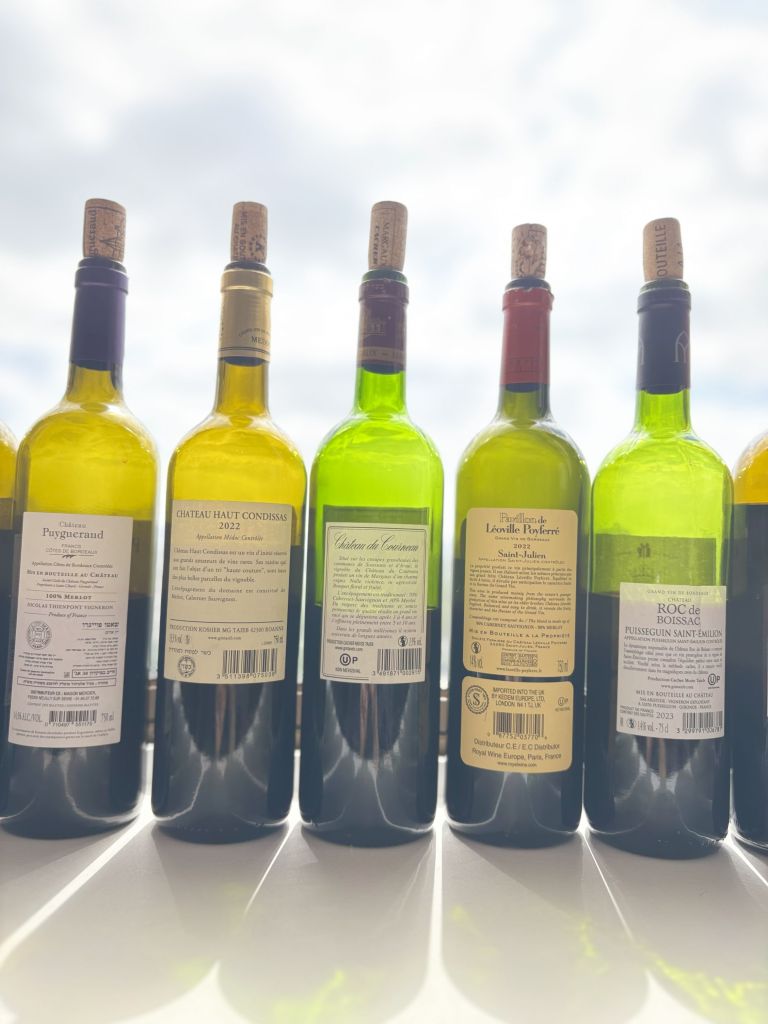
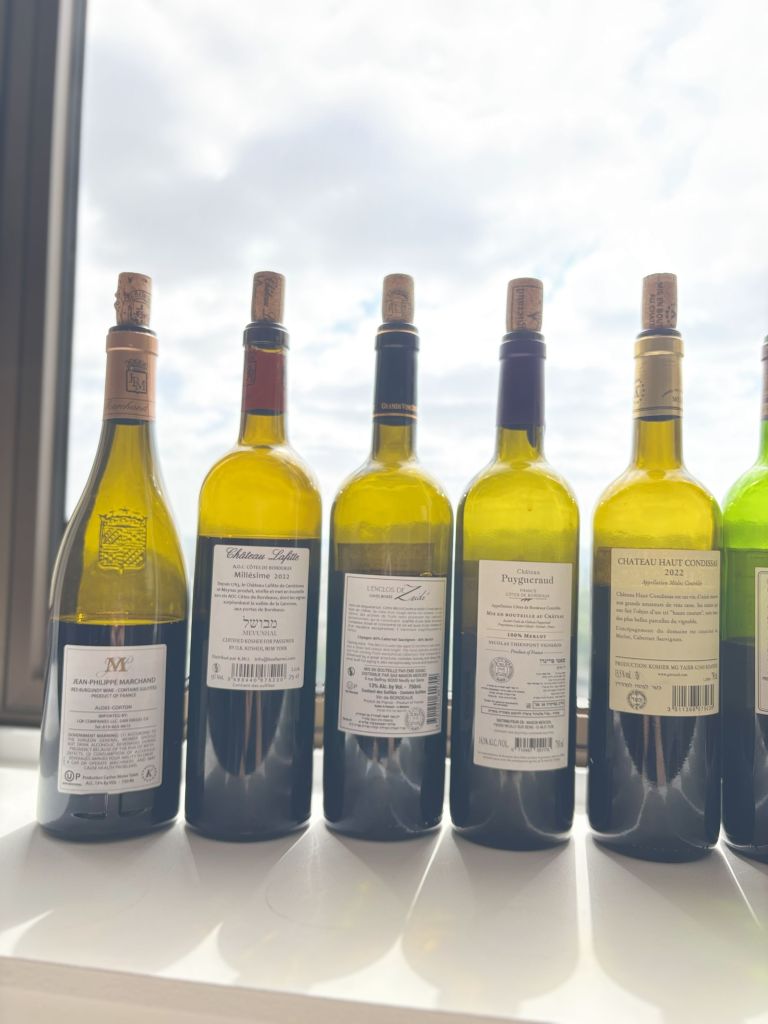
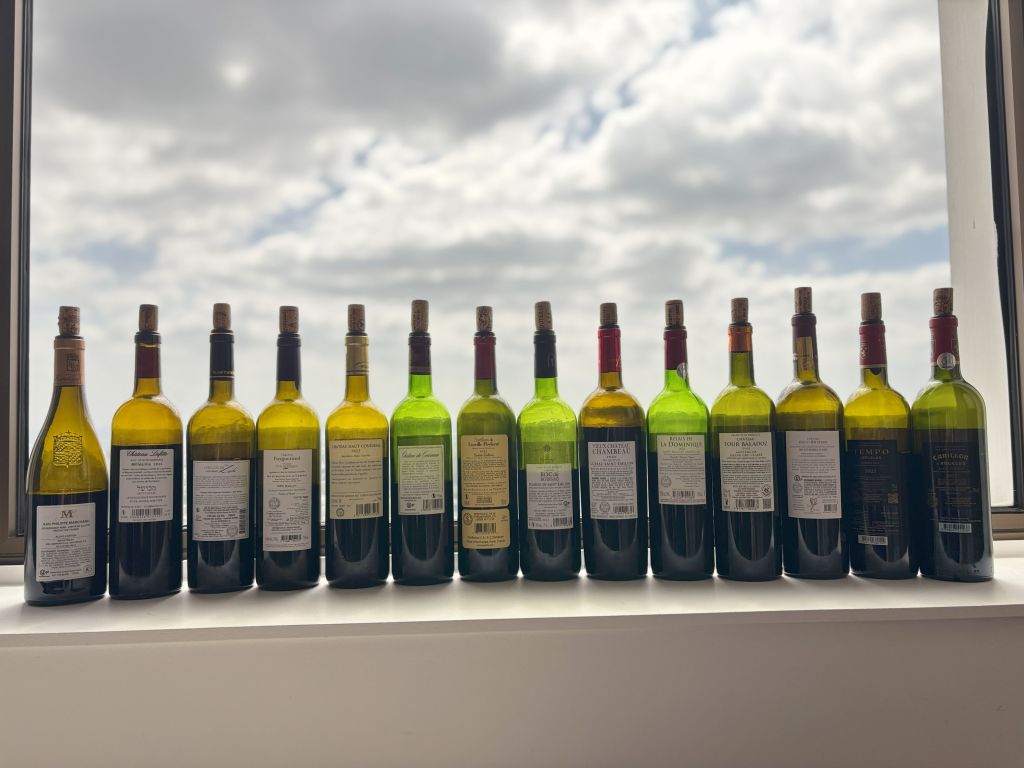
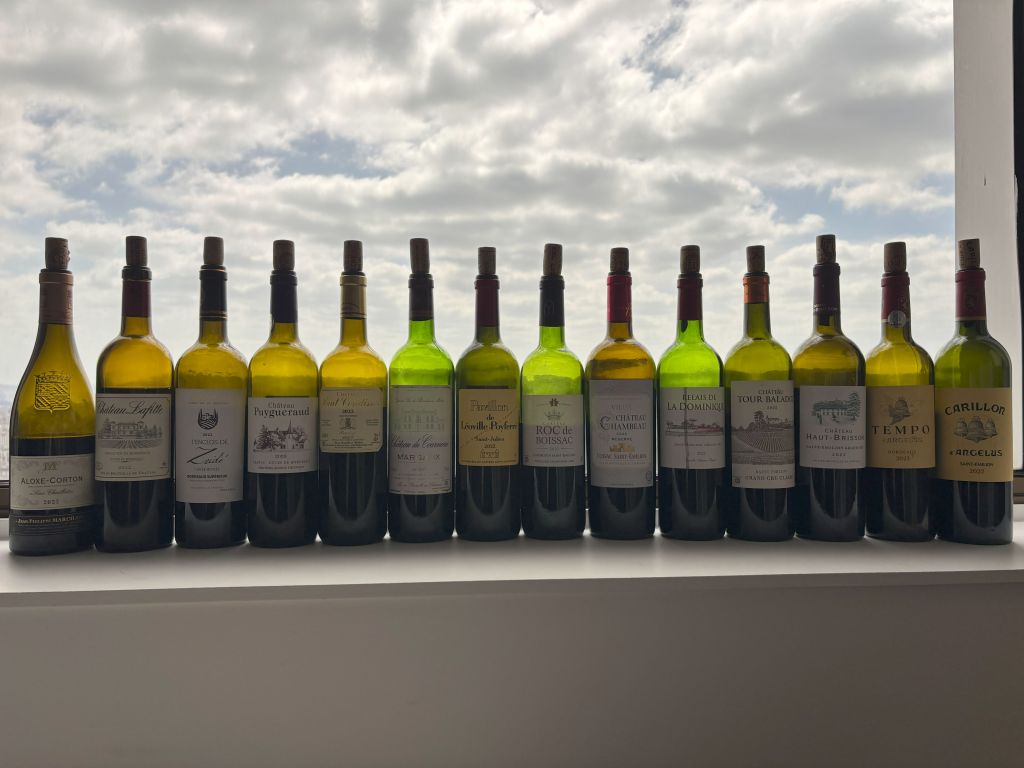
2023 Jean-Philippe Marchand Aloxe Corton, Sous Chaillots, Aloxe Corton – Score: 92 (QPR: WINNER)
The nose of this wine is solid, with pomegranate, dried cranberry, plum, cherry, rich smoke, roasted herbs, minerality, and red floral notes. The mouth of this medium-plus-bodied wine is lovely; it is ripe, not candied, more like a Pommard or Volnay, with incredible acidity, nice balance, along with layers of ripe and juicy pomegranate, dried cranberry, tart and juicy Bing cherry, all wrapped in mouth-draping tannin, rich smoke, and lovely roasted herbs. The acidity, juicy fruit, and smoke take center stage. Bravo! The finish is long, ripe, balanced with smoke, ripe, tart, and juicy fruit, with floral notes, and bitter mint flavor. Bravo! Drink by 2030, maybe longer; it feels missing in the tannin. (tasted May 2025) (in Paris, France) (ABV = 13%)
2024 Elvi Wines Vina Encina Tinto, La Mancha (M) – Score: 82 (QPR: EVEN)
The nose of this wine is a bit too ripe and shows more like a Beaujolais than a Tempranillo. Showing candied lifesaver and blue fruit. The mouth of this light-bodied wine is ripe, candied, without the acidity it needs, but it has fruit that is candied and is a bit green as well. Drink by 2025. (tasted May 2025) (in Paris, France) (ABV = 14%)
2022 Elvi Wines Adar, Ribera del Jucar (M) – Score: 91 (QPR: WINNER)
The nose of this wine is ripe, but more controlled than previous vintages, with nice minerality, smoke, soy sauce, and roasted meat aromas. The mouth of this medium-plus-bodied wine is ripe, and the acidity is great, with notes of soy sauce, sweet oak, blackberry, plum, nice graphite, soft tannin, and roasted herb. The finish is long, ripe, and candied, yet balanced with acidity, featuring notes of charcoal, sweet vanilla, roasted meat, and soy sauce. Drink by 2027. (tasted May 2025) (in Paris, France) (ABV = 13%)
2022 Elvi Wines Herenza, Crianza, Rioja – Score: 91 (QPR: WINNER)
The nose of this wine is nice, showing good acidity, pop, tart fruit, loads of smoke, intense sweet dill, hickory, ripe fruit, nice coffee, and umami. The mouth of this full-bodied wine is lovely. There is nice sweet oak, but the wine is balanced, with great acidity and smoke. At first, it is closed, but with time, it reveals blackberry, plum, and dark cherry flavors, along with a smooth mouthfeel, fine tannin, and lingering smoke. The finish is long, ripe, and balanced, with more sweet oak, intense sweet dill, lovely vanilla, and deep loam. Nice!! Drink by 2028. I think this vintage will not last as long. (tasted May 2025) (in Paris, France) (ABV = 14%)
2023 Capcanes Peraj Ha’abib, Montsant – Score: 92 (QPR: WINNER)
This is a return to what I liked about Peraj Ha’abib in the past: smoky, dirty, earthy, charcoal, and tar-driven wine, with nice red and blue fruit. The mouth of this medium-plus-bodied wine, with ripe blackberry, plum, juicy boysenberry, smoke, tar, charcoal, intense tannin, and layers of fruit that come at you, and yet you are almost refreshed – an intense experience that has the bracing acidity to pull it all off. The finish is long, spicy, with smoke, cloves, vanilla, cinnamon, and more tar and charcoal. Bravo! Drink until 2030. (tasted May 2025) (in Paris, France) (ABV = 15%)
Final Tasting from my trip to Paris – November 2023
As stated in my previous post, I was in Paris in November, with Avi Davidowitz from Kosher Wine Unfiltered. The number of boxes in our room was not nearly as insane as last year. Last year, we had some 80 wines, this year we were at a measly 62. Of those 62, Avi did not get a chance to taste all of them, as he had to get back to Israel. It was a miracle he was even able to come in the first place and I really thank him and his family for him making it to Paris with all that was going on in Israel.
We were in Paris for a week and during that time Avi not only got to finally see some of Paris but we had three organized tastings and we had some Hotel time to taste other wines. Given the constraints, we sadly, did not have time to do these blind. I hope next year, we will make it a priority. Heck, at this point Avi has seen as much of Paris as I have, though he really does need to go to the Musée de l’Orangerie and some more of Musee d’Orsay. Heck, even a bit of the Centre Pompidou will not hurt him, but we have next time! B”H!!!
Like last time, I wanted to break up the normal approach, or taste wines from the distributor or wine producers and instead taste the wines in their respective groups. So the wines listed below are in the order we tasted them and in the groups, we tasted them.
Rhone & White Wines
Red Rhone wines were the first round of wines we tasted. I will take the blame here. I normally get rid of the white wines first, but I wanted to stick to regions and we did not have all the wines at the start, so yeah, the tasting order, at the start is a bit wonky.
Most of these wines were from Cedev, but a few also came from Yavine.fr. There were ten reds and three whites. The overall impression of the 13 wines was not impressive, though there were two nice wines from Yavine and Les Vins de Vienne and one from Domaine de Corps de Loup.
To start, the prices of some of these wines in France are outrageous and they are no better here in the USA (though some of these are only available in Europe). The others are barely OK wines and the price really is irrelevant. The best was the Yavine Les Vins de Vienne Crozes-Hermitage (white and red). The Domaine de Corps de Loup’s price was outrageous but it is a nice enough wine.
The Cedev wines rated OK to poor. The showing may be their best yet, but I have no need to buy any of them. They do have some interesting wines, like a Kosher red Vacqueyras, I just wish they tasted better.
In the end, the relationship between Yavine and Les Vins de Vienne continues to produce good wines.
Finally, if someone had asked me the day I came home, what was the best NEW wine I tasted on your trip – the answer would have been very simple – that is the 2021 Chateau Olivier Blanc. DONE. I would then have dropped the mic and walked away. It is an incredible wine! The 2020 vintage was nice enough, but the 2021 is shockingly incredible. It is clear that the 2021 vintage is really not good for Cabernet-based wines or even for some Merlot-based ones. It feels a bit like 2013 when the whites were incredible. We had no kosher white 2013 wines, but we had the 2013 Piada, yeah it is white, but it is sweet, and yeah, that was/is incredible!
2021 is a tough vintage for Bordeaux and 2022 is NOT what folks have hyped it – so far
This section is going to be tough. The 2021 vintage is a lost cause. Sadly, a large number of Bordeaux wines were made in 2021. There were no red wines made in 2021 from the wines we tasted in the hotel that were QPR WINNERs. There are four 2022 QPR WINNER wines but I continue to stress, that in the kosher world, for me, so far, 2022 is not the panacea or quality that the non-kosher world is hyping. Sure, we have not yet tasted the Chateau Pontet Canet. LOL! My real hope is that the 2020 Moulin Riche, Montviel, Royaumont, and so on, will NOT be like the 2018 vintage! NO! Please no! We want more of the 2014/016 vintage. Sadly, from what we have seen so far in the kosher wines, it is not what those on the outside are talking about. But, the final answer will be when we get to taste the big boys in November and Feb 2025. Yeah, 2025!!
Of this group, the standouts were the Taieb 20222 wines. No surprise here, Taieb continues to prove that great wine does not need to come from the Grand Cru names. Still, there were 2022 wines that were a ripe mess, but that happens with every vintage. My main issue here is that outside of these four wines we have found no other 2022 vintage that we liked enough to give it a QPR WINNER score. As stated, time will tell.
Other regions tasted with Avi
Literally, nothing here to talk about – next! So much pain!!
Elvi Wines
Elvi has another two QPR WINNER wines, while the 2020 Rioja Crizana (Mevushal and not) is not my cup of tea. The 2021 Clos Mesorah and the 2022 Herenza White are lovely wines. Sadly, because Royal can not sell the Herenza White (AKA Invita), the only place I get to taste the current vintage is in Paris or Europe. It is pathetic, that the USA cannot appreciate the joy and happiness of the Herenza white, but hey, that is OK! They sell out in Europe anyway, this is just the loss to those of us living in the USA!
The 2021 Clos Mesorah is another WINNER and yeah, lovely wine, ripe, bold, and concentrated, but with lots of soy sauce and umami. Great stuff and it shows the complexity that so many other wines we tasted lacked.
Other regions tasted without Avi
This is mostly a press release for the Terra di Seta wines I have yet to taste! JOKING, I do not do a press release wine posts, but yeah, the wines are nice. Look, something has changed at Terra di Seta since 2019, I do not know what it is. Sure, the 2019 Chainati Classico was not bad, it was a bit short, but ok. The 2020 vintage was OK as well, while the 2021 vintage was a real mess. The 2019 Riserva was a hard pass for me at the start. It took a couple of days and then I came around to like it enough but even there, the Riserva did not meet what I expected from TDS. Time will tell what is happening or if the Riserva or Assai are good in the later vintages. I have always felt that the Riserva wines were the real age-worthy wine. I have had my issues with the Assai. Still, something is amiss in the last three years. I am hoping that things will change back soon!
I tasted a bunch of wines in June of 2023. They were at a wine event and they were imported by BAM Imports. I wrote about them here. Well, it turns out I had them again, without Avi in Paris and they showed far better. This can always be an import issue, bottle variation, or who knows what. Still, the concern is clear and the wines were not evil in Paris, so who knows!
Finally, I had a couple of wines in the hotel after Avi left and the WINNER of those was a lovely Ribeauville Pinot Noir! I know the joke, Kosher Alsace Pinot Noir is too cheap to clean the car with. Still, this vintage was a SOLID QPR WINNER. Of course, import it to the USA, and goodbye QPR! Still, for those in Europe, ENJOY! This is a daily quaffer HOMERUN!
Where can you buy these wines?
So, the Cedev wines are in the USA, I have no idea what stores are selling their wines sorry. The Olivier and others from Mercier are imported by M&M (AKA Ralph) and sold by Kosher Wine Direct. The Taieb wines will make their way to the USA soon, and should be available by Liquid Kosher, and Elk (you can contact Elk, listed to the right on the desktop view of this page) has/should have them as well. Finally, the TDS and Elvi wines will get to the USA soon or are already here. The biggest issue I find, outside of Royal Wine produced wines, is distribution for the kosher wine buyer. It is almost impossible for the average Kosher wine-buying Joe, to know where to buy each and every SKU/wine, it is crazy!
Thoughts on this tasting
OK, so overall, this tasting was a disaster, much like most of our hotel wine tastings. Look, Kosher plonk exists in spades in all regions of the world! The USA may have the largest availability to them, but Paris is not far behind! That is the MAIN takeaway! Followed by that is the horrible 2021 vintage (other than white wines). Finally, 2022 is not all it has been cracked up to be. OK, that is a wrap for Paris 2023! Looking forward to my next trip over the pond!
Before I forget – Avi took all the pictures from this trip so if you dislike them, blame him. If you love them disregard the previous sentence! Thanks, buddy!! Finally, while most of these deliveries were to the hotel this time, my man Ari Cohen, AKA El-Presidente of Bakus Wines, still put up with our many deliveries. Thanks as always! These hotel tastings could never happen with you, my man!!!
The wine notes follow below – the explanation of my “scores” can be found here and the explanation for QPR scores can be found here:


—————————— Rhone & White Wines ———————————————-
2022 Domaine La Martinelle Cotes du Rhone Villages Visan, Cotes du Rhone – Score: 78 (QPR: POOR)
This wine is painful, it smells hot, it tastes hot, and it feels painful, literally. It also tastes like the wine came out of the wine vat early, AKA, hard pass! The wine has no acidity, loads of astringent, and uncontrolled tannin. Next! (tasted November 2023) (in Paris, France) (ABV = 14.5%)
2022 Vignobles Vuillemin de Valois Bonne Etoile, Cotes du Rhone Villages – Score: 87 (QPR: EVEN)
This wine is a blend of 70% Syrah, 15% Grenache, and 15% Carignan. This is a solid wine for a good price the wine has nice acidity, showing blue, red, and green notes, and earthy, smoky, dirty, and loads of graphite. The mouth of this medium-bodied wine is solid is nice, with good acidity, nice tannin, good fruit, herbs, nice blueberry, raspberry, roasted herbs, soft tannin, and graphite. The finish is nice, tannic, fruity, simple, and not asking for much. Drink now. (tasted November 2023) (in Paris, France) (ABV = 14%)
Another awesome list of Elvi Wines
OK, so this week was the craziest one I have had both professionally and communally in a very long time, but I refuse to not post every week and hopefully more until I catch up.
So, enough about me, and Gemar Chatima Tova to you all. May you all be blessed with a year/life filled with all the good you can carry and then more, health, happiness, success, and many good wines to share with friends and family!
So, now back to wine, this post is about Elvi Wines, I have written many times about Elvi Wines, and the first post I wrote about Moises and Elvi Wines is this. Truthfully, nothing has changed about that post, in regards to Elvi Wines, other than the labels and a few wines being dropped to streamline the marketing of the wines. My next main post on Elvi Wines was when I visited the winery with my wife. The longest post, wine-wise was when I flew over for two days and we did a crazy number of verticals with Moises and Anna!
Before, in between, and after, I have been consistently posting their wines in my QPR posts, wines of the year, and so on. Why? Because they make exceptional wines at reasonable prices and they make a great selection of them under many labels. The labels have evolved, and some wines dropped, but overall, since I met Moises one day in San Francisco, tasting through the wines, I heard the story, the dream, and we have all been blessed to watch the trajectory of the winery. It continues to evolve, creating wonderful wines for a reasonable price while proving that Cabernet Sauvignon is not the only red wine that you can sell to the kosher wine buyer.
It is still harder to sell wines as diverse and different as Elvi does. There is no Cabernet, and there is no Merlot, they find their way into the EL26 blend, but overall, Elvi is an expression of Spain – not an expression of the kosher wine palate. Elvi typifies Spain to the kosher buyer more than any other option and it has continued to excel in doing it. Sadly, we have seen Capcanes, which is a 5-minute drive from Clos Mesorah, take a large step backward. They too showed the potential of Spain, as a new-world wine in old-world clothing. Sadly, they have drunk from the same fountain of fruit, that so many Israeli wineries have, and they have lost their way. Thankfully, Elvi Wines, Clos Mesorah, and Vina Encina continue to not only execute great wines they also are improving and growing with new vineyards and winery plans.
Many of these wines were sent to me by Moises in May and I tasted them in my Paris Hotel room, an absurdity I am want to do! That happens when your friends bail on you! Yeah, you know who you are!! LOL!
The wine that made me wake up, from my jetlag, and take notice was the 2017 and 2018 Elvi Wines Herenza, Reserva, Rioja. A pair of lovely wines. The 2018 outshined the older brother. We have had great Reserva wines from Elvi, but this one, the 2018, is at a different level, BRAVO!! We had it again, at the KFWE London and there I marveled at it again. Just a crazy good wine!
There are another SIX QPR (Quality to Price Ratio) WINNER wines out of 11. Bravo Moises and Anna, you guys keep raising the bar. Achieving what few can do and blessing us with wines to truly enjoy, wines that are refreshing, captivating, and enjoyed by all! There is FIVE Mevushal wine hiding in here, yes Mevushal! I know! Overall Moises does Mevushal well so that is not a big issue here. Still, thankfully, Moises is not boiling Clos Mesorah or Reserva!
Read the rest of this entryA lovely and expansive vertical tasting at Elvi Wines Clos Mesorah in Montsant – Nov 2021
So, a quick recap of my life over the past 45 days. I was in Paris in November along with Avi Davidowitz of Kosher Wine Unfiltered. Avi and I tasted lots of wines and more posts about those wines are forthcoming. Avi left a few days after he arrived to return to his family in Israel for Shabbat and I stayed Shabbat in France. On Sunday I flew to Spain to taste wines with Moises and Anne, which I will be posting here. Then I flew back to Paris, hung out with family, and then flew home.
Two weeks later, I was back on a plane to Tanzania to climb Kilimanjaro. During the 2 weeks I was home I was training or working the entire time, so I barely got the Royal Wine tasting post up! Thankfully I climbed it safely and returned home. The 7 days on that mountain was the longest stretch of my adult life away from a computer, totally surreal for me! Anyway, I am now home and I will be working on my posts, God willing!
So, now back to wine, this post is about Elvi Wines, I have written many times about Elvi Wines, the first post I wrote about Moises and ElviWines is this. Truthfully, nothing has changed about that post, in regards to Elvi Wines, other than the labels and a few wines being dropped to streamline the marketing of the wines. My next main post on Elvi Wines was when I visited the winery with my wife. Before, in between, and after, I have been consistently posting their wines in my QPR posts, wines of the year, and so on. Why? Because they make exceptional wines at reasonable prices and they make a great selection of them under many labels. The labels have evolved, some wines dropped, but overall, since I met Moises one day in San Francisco, tasting through the wines, I heard the story, the dream, and we have all been blessed to watch the trajectory of the winery. It continues to evolve, creating wonderful wines for a reasonable price while proving that Cabernet Sauvignon is not the only red wine that you can sell to the kosher wine buyer.
It is still harder to sell wines as diverse and different as Elvi does. There is no Cabernet, there is no Merlot, sure they find their ways into the EL26 blend, but overall, Elvi is an expression of Spain – not an expression of the kosher wine palate. Elvi typifies Spain to the kosher buyer more than any other option and it has continued to excel in doing it. Sadly, we have seen Capcanes, which is a 5-minute drive from Clos Mesorah, take a large step backward. They too showed the potential of Spain, as a new-world wine in old-world clothing. Sadly, they have drunk from the same fountain of fruit, that so many Israeli wineries have, and they have lost their way. Thankfully, Elvi Wines, Clos Mesorah, and Vina Encina continue to not only execute with great wines they also are improving and growing with new vineyards and winery plans.

I arrived a few hours late because the train systems in Spain are massively antiquated and stopped running for a few hours. Once I arrived, we had the opportunity to start tasting through many a wine. The plan was simple, taste through the wines of Elvi, in a few verticals. A Vertical tasting, in this example, is when you taste the same wine across many vintages. After some tasting, we would have dinner and then go to sleep. The next day we would taste more, go out and see some lovely architecture, then swing by the new vineyards in Priorat, and then finish the tasting, get dinner, and then sleep early as the flight back to Paris is early.
As stated, eventually I got to the winery and the first vertical we did was all the Clos Mesorah wines from 2009 through 2019, except for the 2011 and 2012 vintages that do not exist. That was followed by a partial vertical of Herenza White (AKA InVita) wines. I appreciate tart and acidic wines like the Invita and they showed well, including some with age on them.
The tastings were really fun because tasting through Clos Mesorah is an opportunity to taste through the years of Priorat. Some vintages were very unique, while others were much akin to each other. Each one spoke of the vintage in their own ways, really inspiring. The one constant is acidity, deeply rooted, much akin to Four Gates and Chateau Malartic. Of course, Clos Mesorah is not as old-world as Chateau Malartic, but it has the acidity from its old-world terroir to balance some of its new-world fruit structure. Four Gates Merlot has the same staying power because of the acid that is so deeply core to its very being.
Tasting with Moises Cohen and Anne was a real joy. I have tasted with them before but this time the lineup was far more extensive and that gave me a chance to see what they look for in wine as they described what they thought they liked about the wines and what stood out in each of them, from their perspective. My notes are always what I taste, but my blog will attempt, at times, to emote some of what I hear from the winemaker or the host. In this case, Anne is very clearly passionate about the wine, it shows from the conversations and the notes she describes. Moises is equally passionate, but you can see him defer to Anne when it comes to the wine. Moises cut his teeth in the wine world on the vines and the terroir but eventually, that comes to the wine. The saying goes; wine is made in the vineyard. Together they make a dynamic duo that comes out in many ways. The artistry of the wine, the labels, the overall style they want – that is a duality between Anne and Moises, but Anne seems to take the lead there. In regards to the vineyards, the plushness of the wine, the weight, the overall mouthfeel, there Moises tends to lead, though Anne is side by side as well. The dance is fascinating to watch, explore, and just stand to the side and let happen. Overall, this tasting left me super happy for many reasons. First of all, Clos Mesorah is one of the most consistently great wines out there, even if the track record is a bit short. However, what stood out is the dance between Moises and Anne and the mutual respect they have for each other. Fun times indeed.
Read the rest of this entryMore white and rose wines from my Paris trip
As stated in my previous post, I was in Paris in June, and while it took forever to post these notes, I am happy to finally be getting to them at this point. I will note, that almost none of these wines are or will be available here in the USA. The Elvi wines will get here eventually and maybe some of the KWI roses, but who knows.
So, returning to the trip, other than hanging out with my family and doing a few tastings in-person with Menahem Israelievitch of Royal Wines Europe, Clarisse and Lionel Bokobsa of Sieva/Bokobsa Wines, and Shlomo Corcos of Guter Wein, I kept to my hotel and tasted wines I bought throughout Paris. I did have a tasting with Ari Cohen and the guys, and that will be a post soon as well.
In the end, these wines were mostly painful, they were all 2020 roses and whites from varied vintages. However, there were some good finds, especially the still unreleased Elvi Herenza Blanc wines, those were lovely! Along with the wines from Richard Winery and Maison Serela.
So, the last time I posted about roses, we had the lovely 2020 Chateau Sainte Marguerite Rose and the 2020 Chateau Sainte Marguerite, Cuvee Fantastique Rose, and I also tasted a couple of roses at the Royal tasting. With that said, I had other roses and they will not change this final set of recommendations, in regards to Roses.
I will not repost all my thoughts on roses and the such or how they are made, please read my last post for all of that information.
This will be a quick and simple post for the roses I had not yet posted to the blog.
Best rose so far in 2021
At this point, I have probably tasted all the roses that I will get to and this is my final set of roses. I probably tasted as many as I did last year, again given the logistics of life today. That will still be fewer than in 2019.
If there are two ideas you get from this post that would be great. ONE: Drink only 2020 roses now. TWO: Drink refreshing roses. A rose that feels heavy, unbalanced, and one that does not make you reach for more, is not a rose I would recommend.
So with that said, here are the best options, if you must have a rose, sadly only a couple of these are worth buying – but so far, these are the best options here in the USA:
- 2020 Chateau Roubine Inspire Rose is the best rose I have tasted so far, by a bit, but sadly, only the one in France.
- 2020 Chateau Sainte Marguerite Cuvee Fantastique Rose – best rose I have tasted for USA-based wines, as the 2020 Chateau Roubine Inspire Rose here is not as good here in the USA.
- 2020 Or de la Castinelle Rose and the 2020 Domaine du Vallon Des Glauges Rose – ONLY QPR WINNERS, though there are some France-based QPR options now as well.
- 2020 Ramon Cardova Rosado – is the best price to rose option out there now. It is not a WINNER, but it is a very nice wine and very well priced!
- 2020 Sainte Beatrice B – is the best of the European Mevushal Rose, with the Roubine a touch behind
- 2020 Hajdu Rose – is the best of the Cali roses (that I have tasted so far)
- 2020 Domaine Netofa Rose/2020 Dalton Rose – nicest of the riper roses (that I have tasted so far)
- 2020 Lahat Vignette Rose – is the best of the Israeli rose, but expensive













